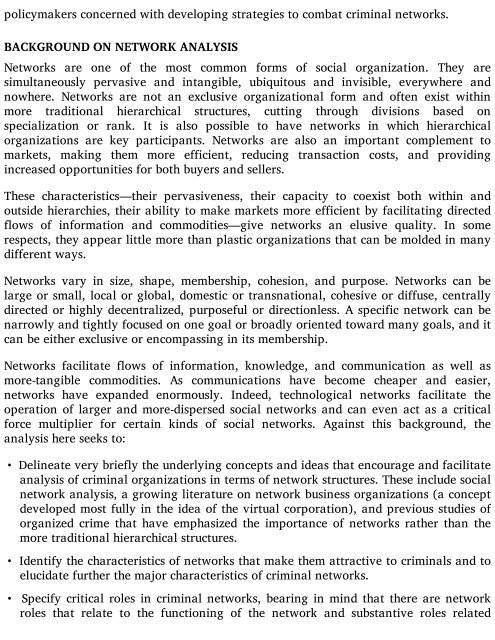RAND_MR1382
Create successful ePaper yourself
Turn your PDF publications into a flip-book with our unique Google optimized e-Paper software.
policymakers concerned with developing strategies to combat criminal networks.<br />
BACKGROUND ON NETWORK ANALYSIS<br />
Networks are one of the most common forms of social organization. They are<br />
simultaneously pervasive and intangible, ubiquitous and invisible, everywhere and<br />
nowhere. Networks are not an exclusive organizational form and often exist within<br />
more traditional hierarchical structures, cutting through divisions based on<br />
specialization or rank. It is also possible to have networks in which hierarchical<br />
organizations are key participants. Networks are also an important complement to<br />
markets, making them more efficient, reducing transaction costs, and providing<br />
increased opportunities for both buyers and sellers.<br />
These characteristics—their pervasiveness, their capacity to coexist both within and<br />
outside hierarchies, their ability to make markets more efficient by facilitating directed<br />
flows of information and commodities—give networks an elusive quality. In some<br />
respects, they appear little more than plastic organizations that can be molded in many<br />
different ways.<br />
Networks vary in size, shape, membership, cohesion, and purpose. Networks can be<br />
large or small, local or global, domestic or transnational, cohesive or diffuse, centrally<br />
directed or highly decentralized, purposeful or directionless. A specific network can be<br />
narrowly and tightly focused on one goal or broadly oriented toward many goals, and it<br />
can be either exclusive or encompassing in its membership.<br />
Networks facilitate flows of information, knowledge, and communication as well as<br />
more-tangible commodities. As communications have become cheaper and easier,<br />
networks have expanded enormously. Indeed, technological networks facilitate the<br />
operation of larger and more-dispersed social networks and can even act as a critical<br />
force multiplier for certain kinds of social networks. Against this background, the<br />
analysis here seeks to:<br />
• Delineate very briefly the underlying concepts and ideas that encourage and facilitate<br />
analysis of criminal organizations in terms of network structures. These include social<br />
network analysis, a growing literature on network business organizations (a concept<br />
developed most fully in the idea of the virtual corporation), and previous studies of<br />
organized crime that have emphasized the importance of networks rather than the<br />
more traditional hierarchical structures.<br />
• Identify the characteristics of networks that make them attractive to criminals and to<br />
elucidate further the major characteristics of criminal networks.<br />
• Specify critical roles in criminal networks, bearing in mind that there are network<br />
roles that relate to the functioning of the network and substantive roles related










![Genki - An Integrated Course in Elementary Japanese II [Second Edition] (2011), WITH PDF BOOKMARKS!](https://img.yumpu.com/58322134/1/180x260/genki-an-integrated-course-in-elementary-japanese-ii-second-edition-2011-with-pdf-bookmarks.jpg?quality=85)
![Genki - An Integrated Course in Elementary Japanese I [Second Edition] (2011), WITH PDF BOOKMARKS!](https://img.yumpu.com/58322120/1/182x260/genki-an-integrated-course-in-elementary-japanese-i-second-edition-2011-with-pdf-bookmarks.jpg?quality=85)





